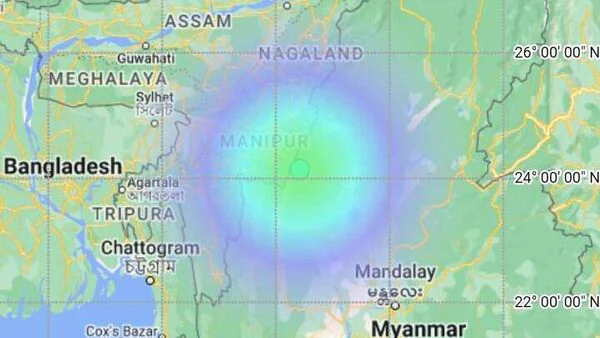5.1 Magnitude Earthquake Hits Myanmar: Tremors Felt Across Assam and Manipur
Summary of the News Article
A 5.1 magnitude earthquake struck Myanmar on January 3, 2025, at 10:02 AM, with its epicenter at a depth of 127 kilometers. The tremors were felt across Assam and Manipur in India, causing momentary panic but thankfully leaving no reports of casualties or property damage. This seismic event follows a smaller 3.8 magnitude earthquake in Manipur’s Tamenglong district the previous day.
Understanding the Impact of the 5.1 Magnitude Earthquake in Myanmar
Introduction
Have you ever felt the ground quiver beneath your feet? It’s a heart-pounding moment, isn’t it? On January 3, 2025, residents of Assam and Manipur experienced this unsettling phenomenon when tremors from a 5.1 magnitude earthquake in Myanmar reached their homes. While no damage was reported, the incident serves as a reminder of the region’s seismic activity. Let’s unpack the details and explore the broader context of earthquakes in this part of the world.
What Happened: The Myanmar Earthquake
The Event in Detail
The earthquake, recorded at 10:02 AM, had its epicenter at Latitude 24.92 N and Longitude 94.97 E in Myanmar. Its depth of 127 kilometers was significant in determining the intensity and reach of the tremors. Such deep quakes often spread their impact across vast areas, which is why Assam and Manipur felt the effects.
Impact on Assam and Manipur
The tremors were strong enough to cause alarm but, fortunately, not destructive. For residents, it was a stark reminder of living in one of the world’s most seismically active regions.
A Precursor Event?
Interestingly, this quake followed a smaller 3.8 magnitude earthquake that struck Manipur’s Tamenglong district just a day earlier. While unrelated, the timing of these events has drawn attention to the seismic vulnerability of the area.
The Science of Earthquakes in Northeast India
Why Is This Region So Seismically Active?
The northeastern part of India is a hotbed of seismic activity due to the collision of the Indian Plate with the Eurasian Plate. This region lies along the Indo-Burmese Arc, a tectonically complex zone known for frequent earthquakes.
Historical Context
This isn’t the first time Assam and Manipur have felt the Earth’s wrath. Major quakes, like the Assam Earthquake of 1950, have caused widespread devastation in the past. These events are a grim reminder of the region’s geological dynamics.
Living with Seismic Risks
Community Response to Earthquakes
When tremors are felt, the immediate reaction is usually one of panic. However, educating communities about earthquake safety can reduce this fear. Drills, public awareness campaigns, and preparedness initiatives can save lives.
Building Resilience
Modern infrastructure in Assam and Manipur has been designed to withstand moderate seismic activity. However, many older structures remain vulnerable. Retrofitting these buildings and enforcing strict construction codes are essential for long-term safety.
Preparedness: What You Can Do
Before an Earthquake
- Create a Family Emergency Plan: Know where to take cover and how to communicate if separated.
- Assemble an Emergency Kit: Include essentials like food, water, medical supplies, and important documents.
- Secure Your Space: Anchor heavy furniture and appliances to walls to prevent toppling.
During an Earthquake
- Drop, Cover, and Hold On: This simple mantra can save lives. Get under sturdy furniture and hold on until the shaking stops.
- Stay Away from Windows: Flying glass can cause serious injuries.
- If Outside, Stay in Open Areas: Avoid buildings, trees, and power lines.
After an Earthquake
- Check for Injuries and Damage: Prioritize safety over possessions.
- Stay Informed: Listen to local authorities for updates and instructions.
- Be Prepared for Aftershocks: These can occur minutes or even days after the main quake.
The Role of Technology in Seismic Monitoring
How Earthquakes Are Detected
Advanced seismometers and accelerometers now provide real-time data on earthquakes. These tools help scientists analyze seismic activity and issue timely warnings.
Early Warning Systems
Countries like Japan have developed early warning systems that can alert people seconds before an earthquake’s strong waves arrive. While India’s system is still developing, such technology could significantly reduce casualties in the future.
The Importance of Awareness and Education
Why Drills Matter
Regular earthquake drills in schools, offices, and communities ensure that people know what to do when disaster strikes.
Educating the Public
Knowledge is power. Teaching communities about the science of earthquakes, the risks involved, and safety measures can make a world of difference.
Conclusion
The 5.1 magnitude earthquake in Myanmar was a reminder of the seismic realities facing Assam, Manipur, and the broader northeastern region. While the absence of damage is a relief, it highlights the ongoing need for preparedness and resilience. By investing in education, infrastructure, and technology, communities can better navigate the challenges posed by living in a seismically active zone.
FAQs
- Why did Assam and Manipur feel tremors from an earthquake in Myanmar?
Earthquake tremors can travel over long distances, especially when the quake is deep, as was the case with this 5.1 magnitude event. - Is the northeastern region of India prone to earthquakes?
Yes, it lies near active tectonic plates, making it one of the most seismically active regions in the world. - What should I do during an earthquake?
Follow the “Drop, Cover, and Hold On” method to protect yourself from falling debris. - Are there early warning systems for earthquakes in India?
While India is developing its system, advanced seismometers currently provide limited early warnings in some areas. - How can communities prepare for earthquakes?
By conducting drills, retrofitting buildings, and educating the public about safety measures, communities can reduce risks significantly.



